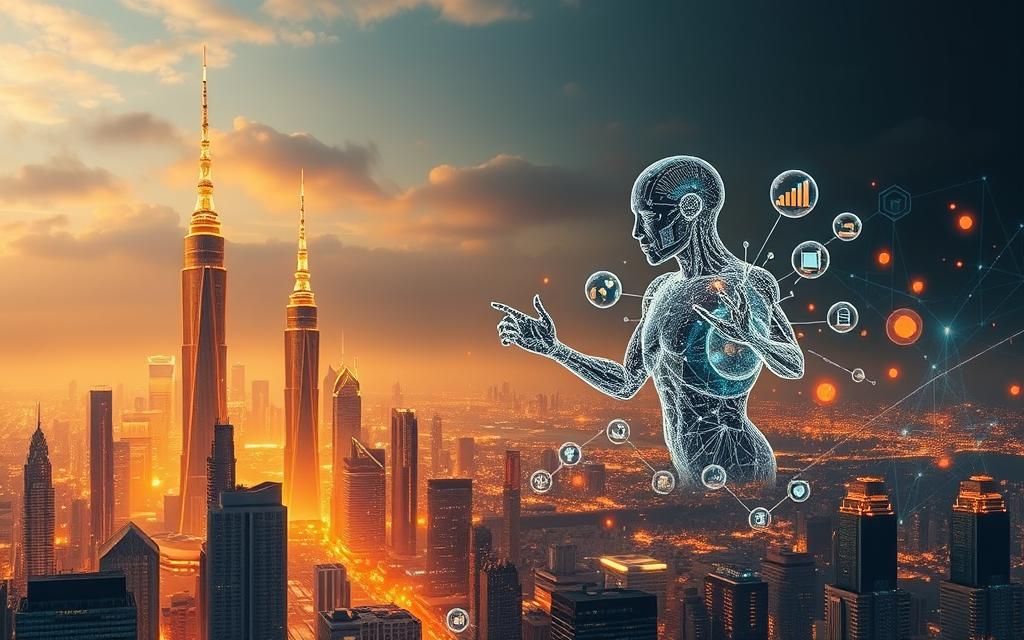Table of Contents
Artificial intelligence is reshaping industries at an unprecedented pace. Over 72% of companies now leverage this technology, according to McKinsey. The global market grows at 38.1% annually, proving its lasting impact.
Massive data availability fuels smarter decision-making. Organizations achieve 40-50% productivity gains in knowledge work. Amazon’s logistics optimization, for example, saves millions yearly.
With 80,000 firms developing solutions worldwide, the potential is vast. This article explores strategic advantages and operational improvements driven by intelligent systems.
Introduction: The AI Revolution in Business
From Alan Turing’s 1950 foundational work to today’s real-world applications, artificial intelligence has evolved from theory to transformative technology. Adoption surged 270% since 2019, with industries reaping benefits like $150B in projected healthcare savings by 2026.
Critical infrastructure advancements enabled AI’s rise. Cloud computing and neural networks now process data 18 times faster, as shown in Deloitte’s mining study. Generative models like GPT-4 further accelerated adoption, automating creative and analytical tasks.
Harvard Business Review categorizes AI’s business impact into three areas:
- Process automation (e.g., invoice processing)
- Cognitive insight (predictive analytics)
- Engagement (chatbots like Bank of America’s Erica, handling 2M daily interactions)
Rather than replacing humans, AI enhances collaboration. Teams now blend human intuition with machine precision—optimizing workflows while reducing errors. This synergy defines the modern workspace.
How AI Can Change Your Business Through Automation
Businesses achieve operational excellence when repetitive processes become automated. Intelligent systems handle mundane tasks like data entry and scheduling, reducing human error by up to 90%. Amazon’s delivery route optimization saves millions annually, proving machine precision outperforms manual planning.
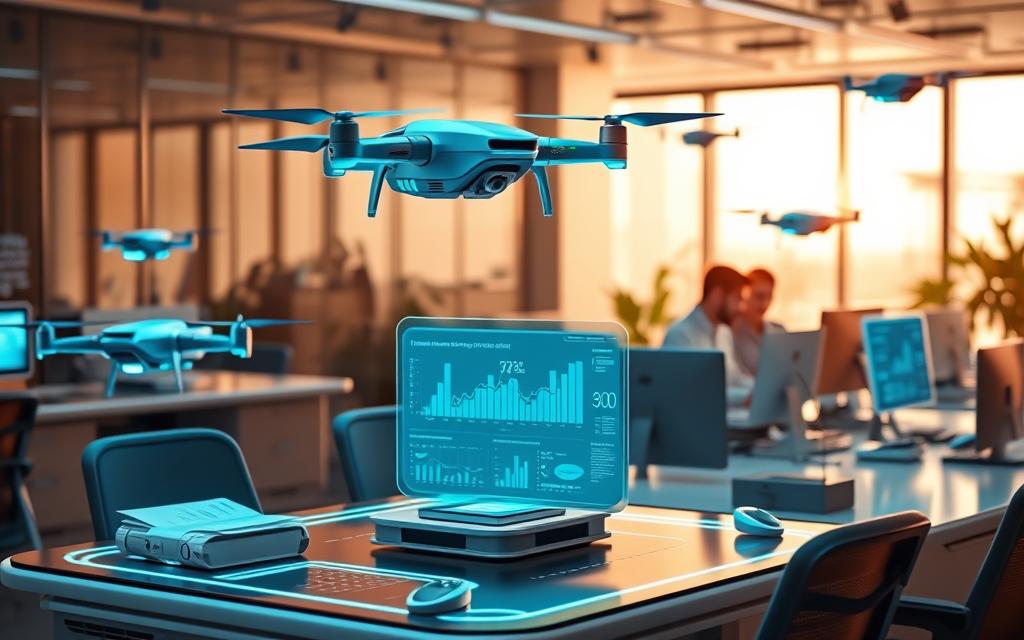
Streamlining Repetitive Tasks
Walmart’s AI inventory system slashes overstock costs by 30%, while HR departments automate payroll with 99.9% accuracy. A Deloitte study shows manual data processing takes 3× longer than automated solutions.
“Automation isn’t about replacing people—it’s about amplifying their potential,”
notes a McKinsey analyst.
Boosting Productivity and Reducing Costs
Manufacturers using robotics report productivity jumps of 40-50%. Labor costs drop when AI allocates shifts based on demand forecasts. Forrester predicts 59% of firms will cut expenses through automation by 2025. The result? Faster operations and higher profit margins.
Enhancing Decision-Making with AI-Driven Data Analysis
Advanced analytics tools transform raw numbers into actionable business insights. By leveraging algorithms, organizations uncover hidden patterns in big data, enabling faster, more accurate decisions. This shift from intuition-based to data-driven strategies is redefining competitiveness.
Big Data Processing Tools
Platforms like Apache Spark and Hadoop process terabytes of data in minutes. Traditional methods take days to analyze similar volumes. Machine learning enhances data analysis by identifying trends humans might miss.
Retail giants like Walmart use these tools to predict demand with 95% accuracy. Their inventory systems adjust in real-time, reducing waste and stockouts. This precision directly impacts profitability.
Real-World Impact: Retail and Finance
In retail, algorithms power personalized marketing, boosting conversion rates by 35%. For example, AI-driven personalization tailors recommendations based on browsing history.
Banks deploy similar tech for fraud detection. AI scans millions of transactions, flagging anomalies with 99.8% accuracy. JPMorgan’s COiN platform reviews legal documents in seconds—a task that once took 360,000 hours annually.
“Data is the new oil, but AI is the refinery turning it into value.”
Healthcare and supply chains also benefit. Predictive analytics forecast equipment failures or delivery delays, saving millions. Tools like Tableau visualize complex datasets, making strategic planning intuitive.
Personalizing Customer Experiences with AI
Modern consumers demand interactions tailored to their preferences. Over 71% expect brands to deliver personalized customer experiences, per McKinsey. Intelligent systems analyze behavior to meet these expectations, boosting loyalty and revenue.
Tailored Recommendations and Marketing
Spotify’s algorithm drives a 30% retention increase by curating playlists based on listening history. E-commerce giants like Amazon use similar recommendations, lifting sales by 35%. Data-driven marketing segments audiences for hyper-targeted campaigns.
Netflix’s suggestion engine saves $1B yearly by reducing churn. Personalization isn’t just convenient—it’s profitable. Tools like Dynamic Yield adjust web content in real-time, matching user intent.
24/7 Customer Support via Chatbots
Bank of America’s Erica handles 2M daily queries, resolving 85% without human intervention. Chatbots answer 80% of routine questions in under 5 seconds—60% faster than live agents. A telecom case study shows AI troubleshooting cuts call volume by 40%.
“Bots excel at speed, but empathy remains a human forte.”
Cost savings are significant. AI support slashes expenses by 30%, yet complex issues still require human nuance. The blend of automation and empathy defines modern customer experience.
Predictive Analytics: Anticipating Market Trends
Neural networks now predict market shifts before they occur, giving firms a critical edge. By analyzing historical and real-time data, predictive analytics identifies trends with 85%+ accuracy—outperforming traditional methods by 40%. Industries from retail to mining leverage these insights to stay agile.
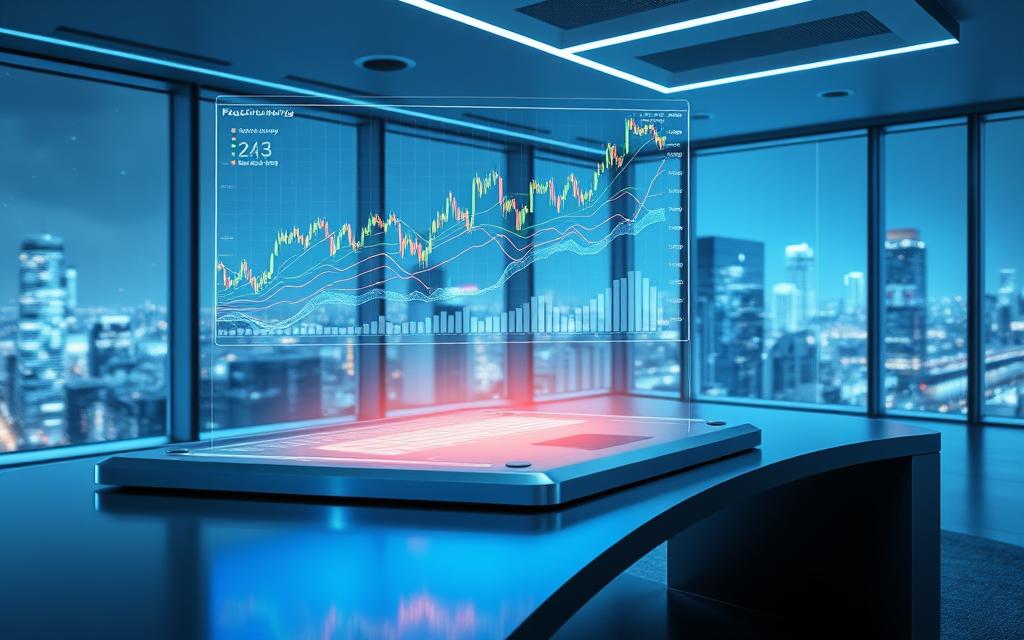
Forecasting Demand and Risks
Retailers like Target use machine learning to predict seasonal demand within 3% variance. This precision slashes overstock costs by 25%. Financial institutions apply similar models to flag risks, reducing loan defaults by 18%.
In agriculture, AI-powered combine harvesters adjust routes based on weather forecasting, boosting yields by 15%. Neural networks process satellite imagery to predict crop diseases months in advance.
Optimizing Supply Chains
JIT 2.0 systems integrate predictive analytics to minimize warehouse waste. Toyota’s AI-driven inventory cuts surplus parts by 30%, while Amazon’s real-time adjustments reduce delivery delays by 50%.
Mining companies deploy sensors to predict equipment failures. Supply chains become resilient as algorithms reroute shipments around disruptions. A Rio Tinto case study shows a 60% drop in unplanned downtime.
“AI doesn’t just react—it anticipates. That’s the game-changer.”
AI-Powered Strategic Planning for Competitive Advantage
Forward-thinking enterprises now leverage predictive models for long-term planning. McKinsey reports 15-20% ROI increases when data drives strategic planning, outpacing traditional methods. These systems analyze market conditions, resource allocation, and operational bottlenecks simultaneously.
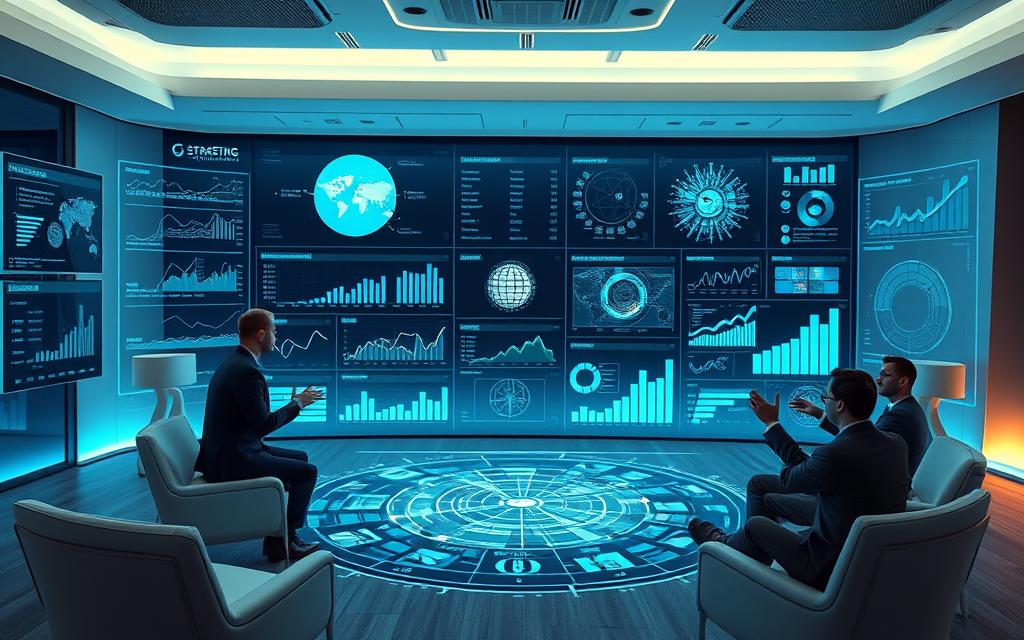
Business Intelligence Tools
Platforms like Tableau integrate with existing ERP systems, visualizing complex datasets. Automotive firms use these business intelligence solutions for product planning, reducing development cycles by 40%. Social listening algorithms scan 10,000+ competitor mentions daily, identifying market gaps.
Resource optimization models automatically adjust budgets based on real-time KPIs. A beverage company case study shows 18% cost savings through AI-driven procurement. The key lies in seamless system integration.
Diagnosing Performance Issues
Root cause analysis now takes minutes instead of weeks. Machine learning pinpoints production line inefficiencies with 92% accuracy. Workforce planning tools predict attrition risks 6 months in advance, allowing proactive retention strategies.
“Data-driven organizations make faster, more accurate strategic decisions—that’s the measurable advantage.”
Merger prediction models assess 200+ financial indicators, achieving 85% accuracy in deal success forecasts. These insights transform performance management from reactive to predictive. The result? Companies stay ahead in volatile markets.
Industry-Specific Transformations: AI in Action
From hospitals to financial institutions, intelligent systems deliver tangible results. Over 38% of healthcare providers now use diagnostic tools, while banks prevent $4B+ in annual fraud. These industry applications demonstrate tailored solutions for critical sectors.
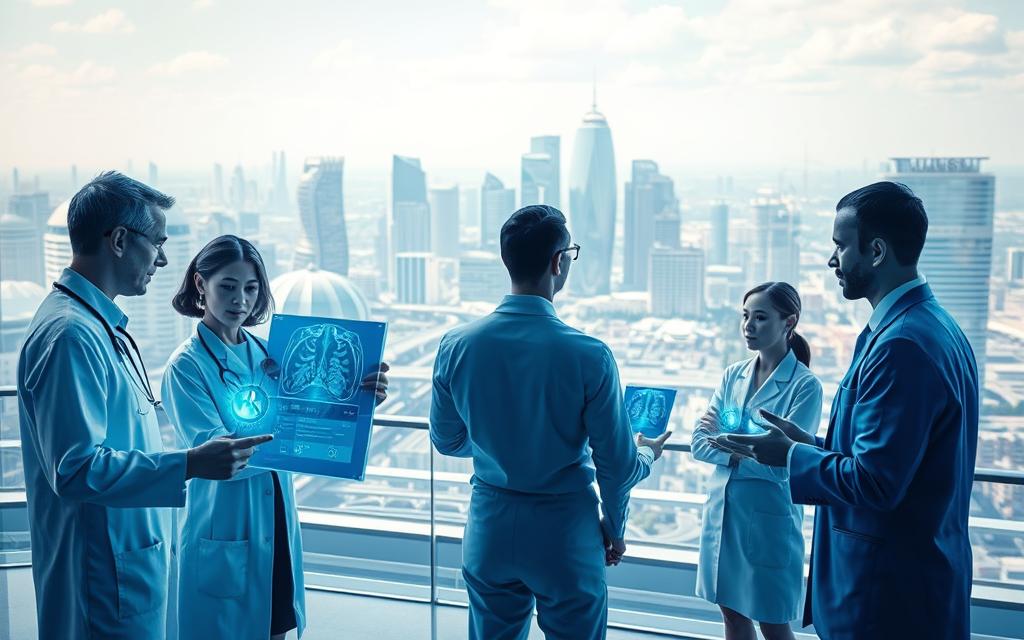
Healthcare and Diagnostics
Medical imaging analysis achieves 99% detection rates for tumors—30% higher than manual review. Algorithms process scans in 2.3 seconds versus 23 minutes traditionally. Key advancements include:
- Drug discovery accelerated by 40% through molecular simulation
- Patient risk assessment models with 89% prediction accuracy
- Remote monitoring reducing hospital readmissions by 17%
The $150B savings potential stems from reduced errors and optimized workflows. Mayo Clinic’s stroke detection system cuts diagnosis time from 30 minutes to 6.
Banking and Cybersecurity
Real-time transaction monitoring flags suspicious activity within 0.8 seconds. Traditional methods take 14 minutes per alert. Cybersecurity systems now show:
| Metric | Traditional | AI-Enhanced |
|---|---|---|
| False positives | 42% | 3.7% |
| Detection speed | 8.5 hours | 47 seconds |
| Fraud recovery | 61% | 93% |
Smart contracts in banking automate 78% of loan approvals. JPMorgan’s COIN platform reviews 12,000 annual contracts in seconds. This industry-specific approach transforms risk management.
“Healthcare and finance demonstrate AI’s adaptability—solving unique problems with precision tools.”
Conclusion: Embracing AI for Future Success
The transformation driven by intelligent systems is no longer optional—it’s a competitive necessity for modern enterprises. With 97% of leaders recognizing its potential, artificial intelligence reshapes industries from finance to healthcare.
Successful adoption requires clear strategies. Start with automating repetitive tasks, then scale to predictive analytics. Workforce reskilling ensures teams maximize these tools effectively.
Ethical considerations remain critical. Transparent algorithms and human oversight build trust and compliance. Hybrid workflows combine machine efficiency with human creativity.
Emerging technologies like IoT and smart cities will further accelerate this shift. Early adopters gain measurable advantages—Microsoft’s case studies show productivity jumps of 20-50%.
The future belongs to organizations embracing this evolution. Delaying implementation risks falling behind in an increasingly data-driven world.
FAQ
What are the key benefits of automation in business operations?
Automation speeds up repetitive tasks, cuts costs, and boosts efficiency. Businesses save time while improving accuracy in workflows like invoicing and inventory management.
How does machine learning improve decision-making?
Advanced algorithms analyze big data to uncover trends and patterns. Retailers and financial firms use these insights for demand forecasting and risk assessment.
Can artificial intelligence enhance customer relationships?
Absolutely. AI-powered chatbots provide instant support, while recommendation engines personalize shopping experiences based on past behavior and preferences.
What industries benefit most from predictive analytics?
Retail, finance, and manufacturing gain advantages. Predictive models optimize supply chains, anticipate market shifts, and prevent equipment failures before they occur.
Which tools help businesses leverage AI for strategic planning?
Platforms like IBM Watson and Salesforce Einstein analyze performance metrics. They identify inefficiencies and suggest data-driven improvements for long-term growth.
How is artificial intelligence transforming healthcare and banking?
Medical diagnostics use image recognition for faster results. Banks deploy fraud detection systems that monitor transactions in real time to prevent cyber threats.


